The Common Kingfisher (Alcedo atthis) is a captivating and iconic bird species known for its striking plumage, exceptional fishing abilities, and widespread distribution across Europe, Asia, and parts of North Africa.
With its vibrant blue and orange feathers, agile flight, and distinctive calls, the Common Kingfisher holds a special place in the hearts of birdwatchers and nature enthusiasts worldwide.
Its presence along rivers, streams, and coastal areas adds vibrancy to riparian habitats and symbolizes ecological health and biodiversity.
Despite its diminutive size, the Common Kingfisher’s beauty and charm have earned it recognition as one of the most beloved birds in the avian world.
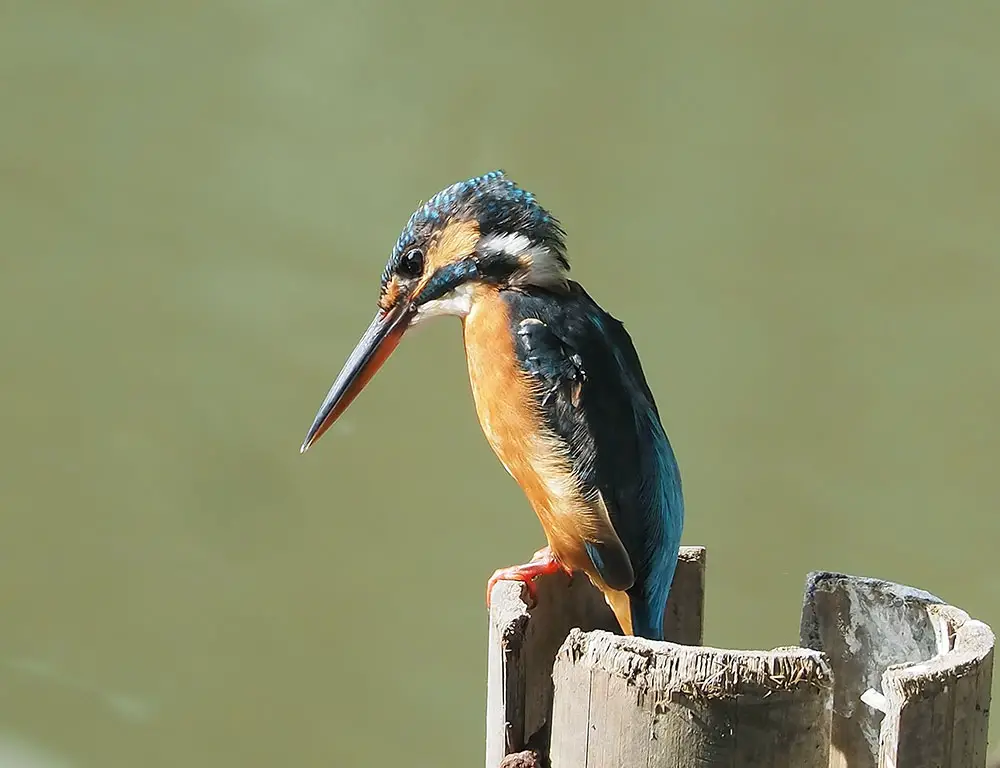
Common Characteristics Of Common Kingfisher
The Common Kingfisher is a small and colorful bird belonging to the Alcedinidae family. It is widely distributed across Europe, Asia, and Africa, inhabiting various habitats near water, such as rivers, lakes, ponds, and coasts.
It is also known as the Eurasian Kingfisher or the River Kingfisher. Here are some of the common characteristics of this stunning and skillful bird:
Physical Characteristics Of Common Kingfisher
The Common Kingfisher is a small and colorful bird belonging to the Alcedinidae family. It is widely distributed across Europe, Asia, and Africa, inhabiting various habitats near water, such as rivers, lakes, ponds, and coasts.
It is also known as the Eurasian Kingfisher or the River Kingfisher. Here are some of the physical characteristics of this stunning and skillful bird:
Size And Shape
The Common Kingfisher is about 16 cm long and weighs around 40 g. It has a compact body, a large head, a short tail, and short legs.
The bill is long, straight, and pointed, adapted for catching fish and other prey. The wings are short and rounded, and the feet are small and weak.
Color And Pattern
The Common Kingfisher has a bright metallic plumage, a blue-green back, wings, and tail, and an orange-red breast, belly, and cheeks. It has a white throat and a white patch on the sides of the neck.
It has a black eye stripe, which extends to the bill. The bill is black on the upper mandible and orange-red on the lower mandible. The eyes are dark brown, and the legs and feet are red.
The male and female are similar, but the female has a reddish lower mandible, while the male has a black one.
Sexual Dimorphism
The Common Kingfisher exhibits sexual dimorphism, which means that the male and female have different appearances. The male and female are similar in size and color, but the male has a black lower mandible, while the female has a reddish one.
This difference can distinguish the sexes, especially during the breeding season.
Moult
The Common Kingfisher undergoes a partial molt once a year, usually after the breeding season. During this time, the bird may lose some of its feathers, especially on the head and the breast.
The molt lasts about a month, and the bird regains its fresh and glossy plumage.
Voice
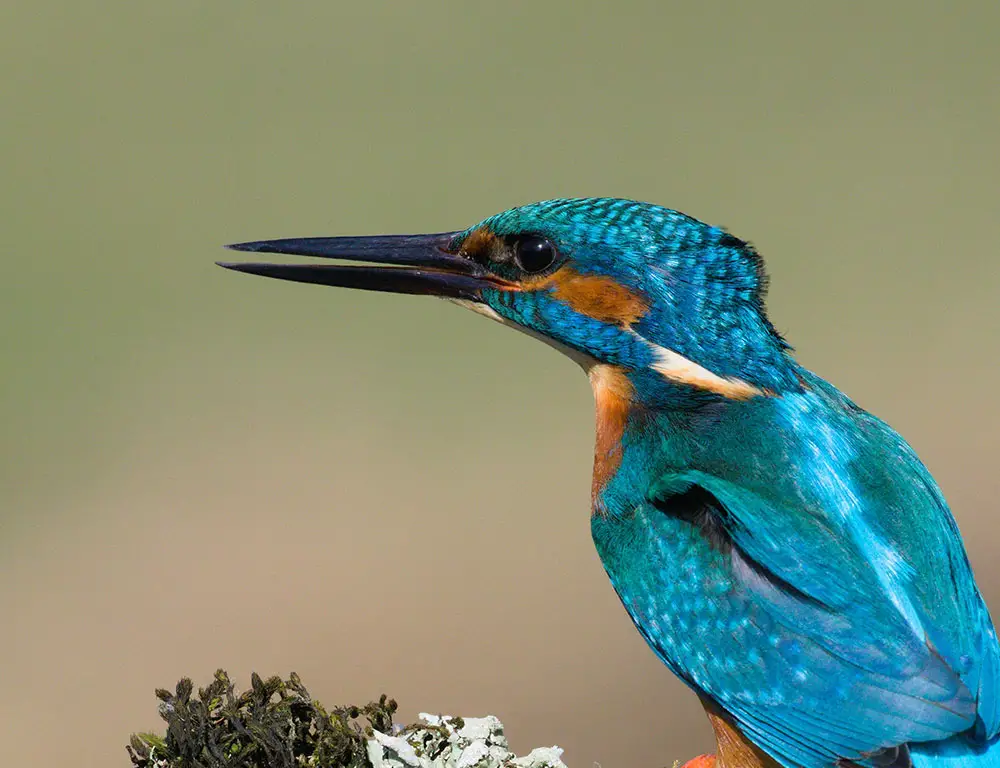
The Common Kingfisher is a vocal and noisy bird producing various sounds, such as chirps, whistles, clicks, and rattles. The most common sound is a loud and piercing “chee” or “chi,” used as a contact, alarm, or territorial call.
The bird also makes a rapid and repeated “chili” or “chili,” used as a flight, courtship, or display call. The bird can also produce a low and harsh “krr” or “kra,” used as an aggression, threat, or warning call.
Diet And Nutrition
The Common Kingfisher is mainly piscivorous, feeding on fish and other aquatic animals such as crustaceans, mollusks, amphibians, and insects. It also occasionally eats terrestrial animals such as lizards, mice, and birds.
The bird hunts by perching on a branch or a rock near the water and diving headfirst into the water to catch its prey. It then returns to its perch, beating the prey against it or killing it.
It then swallows the prey whole, head first. It needs to drink water regularly and may dip its bill into it to quench its thirst.
Reproduction
The Common Kingfisher breeds from March to August, depending on the region. The pair forms a monogamous bond and defends a territory. The nest is a tunnel dug by both sexes, usually on a river bank, a sand bank, or a clay bank.
The tunnel is about 1 m long and 5 cm wide and ends in a chamber. The nest is lined with fish bones, scales, and pellets, which the birds regurgitate. The female lays 5 to 7 eggs, which are white and glossy.
The incubation period is about 19 to 21 days, and the chicks are altricial, which means they are blind, naked, and helpless at birth. The parents feed the chicks with regurgitated fish and remove the fecal sacs from the nest.
The fledging period is about 24 to 25 days, and the young may stay with their parents for some time before dispersing.
Distribution And Habitat
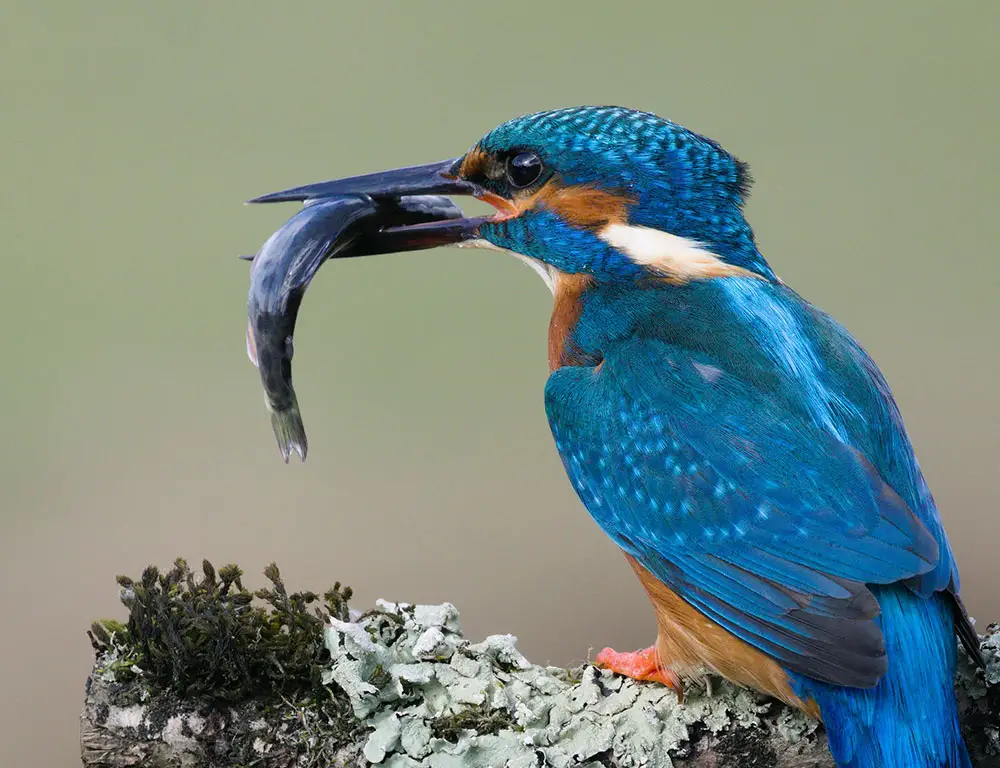
The Common Kingfisher has a natural range that covers most of Europe, Asia, and Africa, from Iceland and Norway in the north to South Africa and Indonesia in the south and east to Japan and the Philippines.
It has also been introduced to New Zealand and Australia. It occupies various habitats near water, such as rivers, lakes, ponds, marshes, swamps, and coasts.
It prefers clear and shallow water with abundant fish and vegetation. It also tolerates human-modified habitats like canals, reservoirs, and parks.
Aviculture
Due to its specialized diet and habitat requirements, the Common Kingfisher is a rare and challenging bird to keep in captivity. It is not a suitable pet for beginners or casual bird lovers and requires a lot of care and attention.
It needs a spacious and secure aviary with a prominent water feature, natural plants, and perches.
It also needs a varied and fresh diet of live fish and other aquatic animals, supplemented with vitamins and minerals. It can live for up to 10 years in captivity but may suffer from stress and diseases.
Survival
The Common Kingfisher is a resilient and adaptable bird that can survive and thrive in different habitats and conditions. It is also a skilled and efficient hunter who can catch its prey quickly and precisely.
Its adaptations help it survive, such as a waterproof and insulating plumage, a protective third eyelid, and a flexible spine.
It can also cope with seasonal changes in food and water availability and migrate or disperse to find suitable resources.
Status
The Common Kingfisher is a widespread bird with an estimated global population of about 1.6 million individuals. It is not considered threatened or endangered and has a stable or increasing trend.
It is, however, vulnerable to habitat loss, degradation, and fragmentation due to pollution, drainage, damming, and deforestation. It is also affected by climate change, which may alter its distribution and migration patterns.
It is also susceptible to predation, collision, and persecution by natural and artificial enemies, such as cats, raptors, and humans. It is protected by law in some countries and appreciated and admired by many people for its beauty and behavior.
Ranging Map Of Common Kingfisher
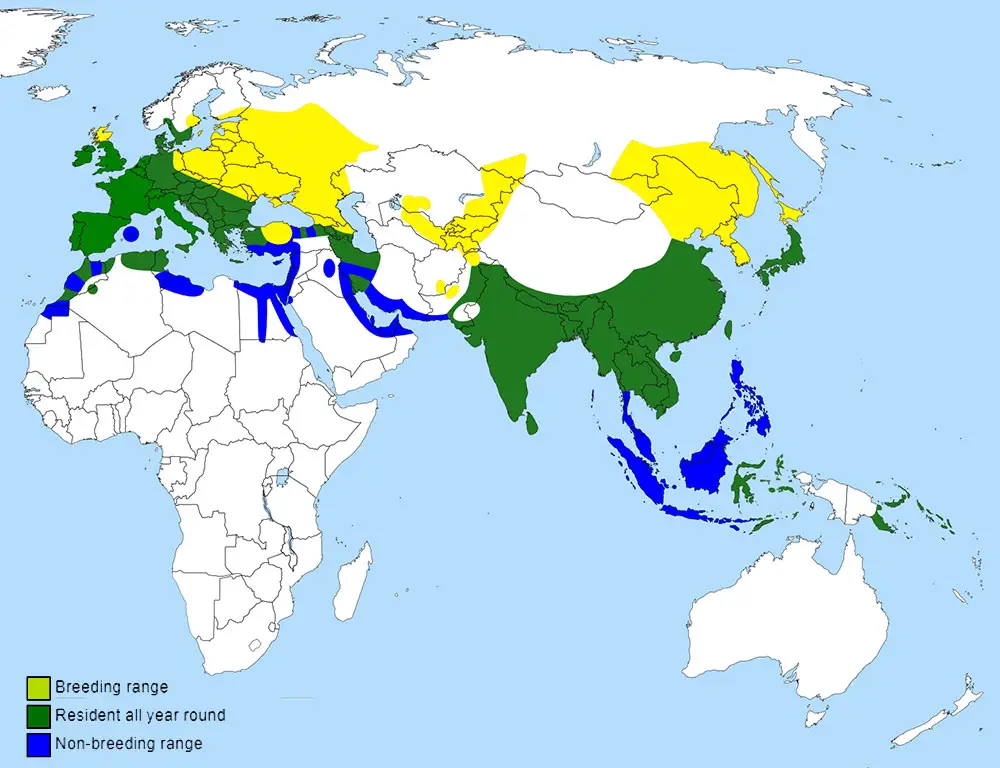
The Ranging Map of the Common Kingfisher (Alcedo atthis) provides a comprehensive depiction of this enchanting bird species’ distribution and habitat preferences.
This map illustrates the global presence of the Common Kingfisher, showcasing its widespread distribution across Europe, Asia, and parts of North Africa.
Common Kingfishers are predominantly found near water bodies such as rivers, streams, lakes, ponds, and coastal areas, where they can readily access their primary prey of small fish.
The map delineates specific regions where the species thrives, highlighting favorable habitats characterized by clear, slow-moving water, abundant vegetation along banks for perching and nesting, and an ample supply of fish.
Additionally, the Ranging Map may indicate areas of seasonal migration or local movements in response to changing environmental conditions.
Taxonomy
Here’s a simplified table of the taxonomy of the Common Kingfisher:
| Taxonomic Level | Classification |
| Kingdom | Animalia |
| Phylum | Chordata |
| Class | Aves |
| Order | Coraciiformes |
| Family | Alcedinidae |
| Genus | Alcedo |
| Species | Alcedo atthis |
This classification places the Common Kingfisher within the animal kingdom (Animalia), the chordate phylum (Chordata), the class of birds (Aves), the order of Coraciiformes, the kingfisher family (Alcedinidae), the genus Alcedo, and the species Alcedo atthis.
Nesting Habit
Here’s a simplified table outlining the nesting habits of the Common Kingfisher:
| Nesting Habit | Description |
| Nest Type | Burrow nester, excavating tunnels in riverbanks, cliffs, or artificial structures |
| Nest Material | Typically lined with fish bones, scales, and regurgitated pellets |
| Nest Location | Near water bodies such as rivers, streams, lakes, or coastal areas |
| Nest Construction | Incubated by both parents lasts around 19 to 21 days |
| Nesting Season | Varies depending on geographic location, typically between March and July |
| Clutch Size | Usually 5 to 7 glossy white eggs |
| Incubation | Chicks fledge after about 23 to 25 days but remain dependent for some time |
| Fledging Period | It can be high, though nest predation and flooding are common challenges |
| Nesting Success | Can be high, though nest predation and flooding are common challenges |
This table summarizes the nesting behaviors and characteristics of the Common Kingfisher, providing insights into its reproductive ecology and habitat preferences.
What Is The Speciality Of Kingfishers?
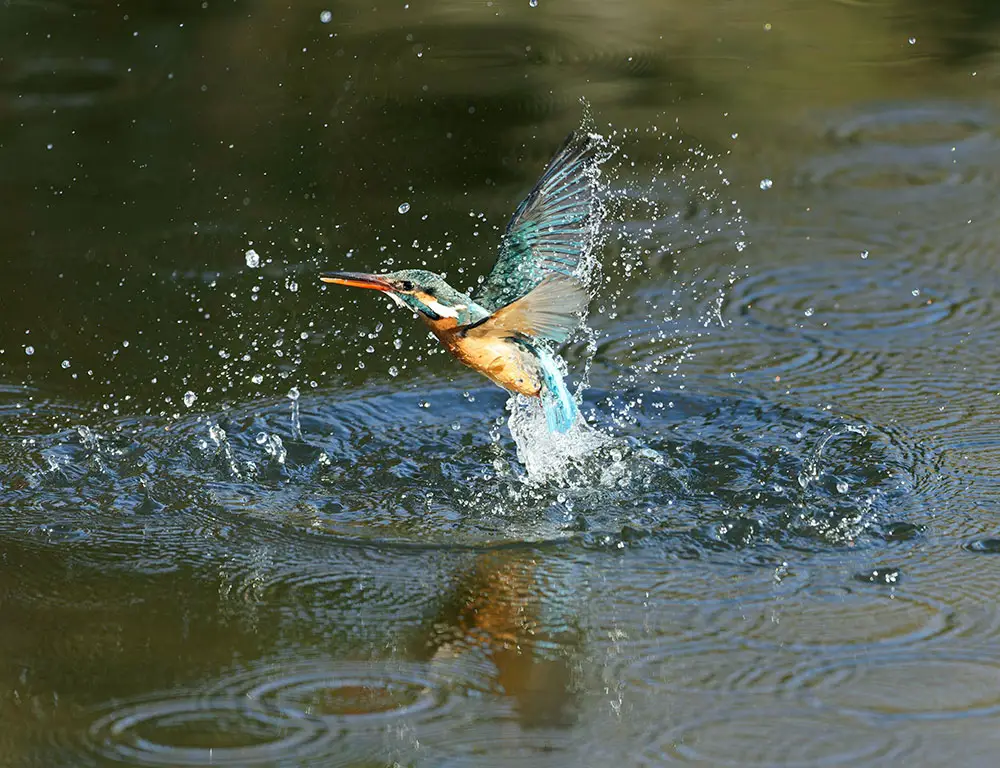
Kingfishers are renowned for their remarkable adaptations and unique behaviors, making them one of the most captivating bird families worldwide. Here are seven specialties that set kingfishers apart:
Dazzling Plumage
Kingfishers are adorned with vibrant plumage, often featuring striking shades of blue, green, and orange. Their colorful feathers serve aesthetic and functional purposes, providing camouflage in their natural habitats and aiding in courtship displays.
Masterful Fishing Skills
Kingfishers are expert hunters with specialized fishing techniques. They have keen eyesight and can accurately judge the depth and location of prey underwater.
They plunge into the water with remarkable agility and precision to catch fish with their sharp beaks.
Nesting Behavior
Kingfishers exhibit fascinating nesting behaviors, often excavating burrows in riverbanks or cliffs for shelter.
They are known for their elaborate courtship rituals, where males present fish to females as part of the mating display, showcasing their ability to provide for offspring.
Territorial Calls
Kingfishers are known for their distinctive calls, which vary between species. These calls serve multiple purposes, including territorial defense, communication between mates, and signaling during hunting.
Each species has unique vocalizations, contributing to its diverse and rich auditory landscape.
Swift Flight
Kingfishers are agile flyers, capable of rapid and direct flight over waterways as they search for prey. Their streamlined bodies and short wings enable them to maneuver swiftly through dense vegetation and narrow spaces, making them efficient hunters in their aquatic habitats.
Global Distribution
Kingfishers are found in various habitats worldwide, from tropical rainforests to temperate woodlands and coastal regions. They have adapted to diverse environmental conditions, demonstrating their resilience and versatility as a bird family.
Cultural Significance
Kingfishers hold cultural significance in many societies, often symbolizing prosperity, peace, and good luck. They feature prominently in folklore, mythology, and art across different cultures, reflecting their enduring appeal and influence on human imagination throughout history.
Kingfishers’ remarkable adaptations, behaviors, and cultural significance contribute to their status as beloved and iconic birds celebrated by birdwatchers, conservationists, and enthusiasts around the globe.
7 Interesting Facts About Common Kingfisher
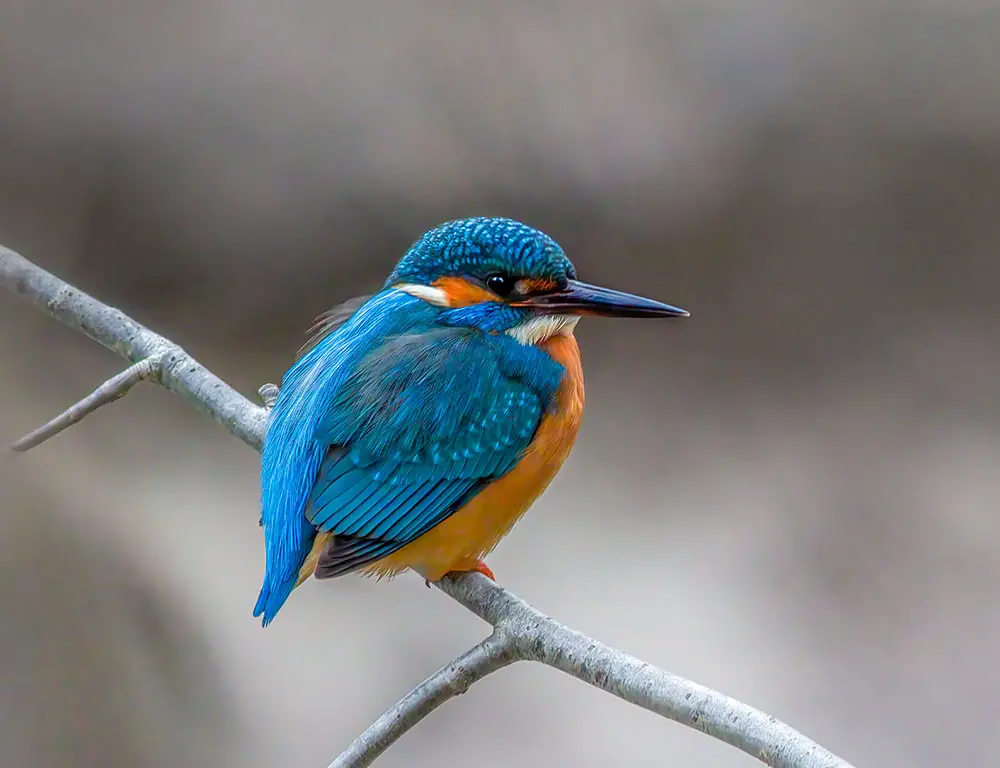
Here are seven interesting facts about the Common Kingfisher:
Vivid Plumage
Common Kingfishers are adorned with stunning plumage featuring bright shades of blue, orange, and white, making them one of the most colorful bird species in the world.
This vibrant coloration serves aesthetic and functional purposes, providing camouflage in their riparian habitats and attracting mates during courtship displays.
Expert Fishers
Common Kingfishers are masterful hunters with specialized fishing skills. They have keen eyesight and can accurately judge the location and depth of prey underwater.
They dive into the water from perches along riverbanks or overhanging branches with remarkable agility and precision to catch fish with their sharp beaks.
Nesting Behavior
Common Kingfishers exhibit fascinating nesting behaviors, often excavating burrows in riverbanks or sandy soil for shelter. They typically lay a clutch of 5 to 7 glossy white eggs, which both parents incubate and care for until hatching.
These caves protect the vulnerable chicks from predators and adverse weather conditions.
Territorial Calls
Common Kingfishers are known for their distinctive calls, which serve various purposes such as territorial defense, communication between mates, and signaling during hunting.
Their high-pitched and rapid “kee-kee-kee” calls are often heard along rivers and streams, especially during the breeding season.
Swift Flight
Common Kingfishers are agile flyers, capable of swift and direct flight over waterways as they search for prey.
Their streamlined bodies, short wings, and rapid wing beats enable them to maneuver effortlessly through dense vegetation and narrow spaces, making them efficient hunters in their aquatic habitats.
Global Distribution
Common Kingfishers are found across Europe, Asia, and North Africa, inhabiting many freshwater and coastal habitats. They have adapted to diverse environmental conditions, demonstrating their versatility and resilience as a species.
Cultural Significance
Common Kingfishers hold cultural significance in many societies, often symbolizing peace, prosperity, and good luck. They feature prominently in folklore, mythology, and art across different cultures, reflecting their enduring appeal and influence on human imagination throughout history.
These fascinating facts highlight the unique adaptations, behaviors, and cultural significance of the Common Kingfisher, making it a beloved and iconic bird species celebrated by birdwatchers and enthusiasts worldwide.
Conclusion
The Common Kingfisher stands as a testament to the wonders of nature, captivating observers with its beauty, agility, and ecological significance.
Its presence in diverse habitats serves as a reminder of the interconnectedness of ecosystems and the importance of conservation efforts to protect vulnerable species and their habitats.
As stewards of the natural world, we must cherish and safeguard the Common Kingfisher and ensure its continued survival for future generations to admire and appreciate.